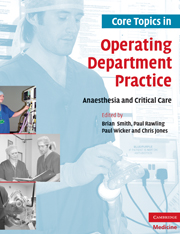Book contents
- Frontmatter
- Contents
- Acknowledgements
- List of Contributors
- Foreword
- Preface
- 1 Introduction: anaesthetic practice. Past and present
- 2 Risk assessment
- 3 ECG monitoring in the recovery area
- 4 The use of cricoid pressure during anaesthesia
- 5 Anaesthetic breathing circuits
- 6 Deflating the endotracheal tube pilot cuff
- 7 How aware are you? Inadvertent awareness under anaesthesia
- 8 Aspects of perioperative neuroscience practice
- 9 Resuscitation
- 10 Intravenous induction versus inhalation induction for general anaesthesia in paediatrics
- 11 Managing difficult intubations
- 12 Obstetric anaesthesia
- 13 Understanding blood gases
- 14 Total intravenous anaesthesia
- 15 Anaesthesia and electro-convulsive therapy
- 16 Mechanical ventilation of the patient
- 17 Perioperative myocardial infarction
- 18 Developing a portfolio
- 19 Accountability in perioperative practice
- Index
- References
9 - Resuscitation
Published online by Cambridge University Press: 13 August 2009
- Frontmatter
- Contents
- Acknowledgements
- List of Contributors
- Foreword
- Preface
- 1 Introduction: anaesthetic practice. Past and present
- 2 Risk assessment
- 3 ECG monitoring in the recovery area
- 4 The use of cricoid pressure during anaesthesia
- 5 Anaesthetic breathing circuits
- 6 Deflating the endotracheal tube pilot cuff
- 7 How aware are you? Inadvertent awareness under anaesthesia
- 8 Aspects of perioperative neuroscience practice
- 9 Resuscitation
- 10 Intravenous induction versus inhalation induction for general anaesthesia in paediatrics
- 11 Managing difficult intubations
- 12 Obstetric anaesthesia
- 13 Understanding blood gases
- 14 Total intravenous anaesthesia
- 15 Anaesthesia and electro-convulsive therapy
- 16 Mechanical ventilation of the patient
- 17 Perioperative myocardial infarction
- 18 Developing a portfolio
- 19 Accountability in perioperative practice
- Index
- References
Summary
Key learning points
Understand resuscitation for acute management of cardio-respiratory arrest and periarrest
Recognise the historic movements in resuscitation
Identify and discuss the patient treatment options using the resuscitation algorithms
Many methods of resuscitation that we now take for granted were developed in the 1950s, including for example, Dr Peter Safar's work with mouth-to-mouth ventilation and oxygen saturation.
One of the earliest and most possible accounts of resuscitation comes in the Old Testament in the second book of Kings: ‘… And he went up, and lay upon the child, and put his mouth upon his mouth, and his eyes upon his eyes, and his hands upon his hands; and he stretched himself upon the child; and the flesh of the child waxed warm’ (Bible, 2 Kings, iv, 34). This passage is a potential description of the biblical figure Elijah performing mouth-to-mouth resuscitation.
The ancient Egyptians over 3500 years ago recorded resuscitation attempts that involved hanging the victim by their legs and applying intermittent pressure to their chest to aid inspiration and expiration.
In 1767 the first life-saving society was founded in Holland, closely followed in Britain in 1774. These early societies focused on near-drowning incidents. This emphasis continued up to the 1960s with the Holgar Neilson method of moving the arms through 180 degrees in a pumping action with the victim lying flat on their back, being the preferred means of removing water from the lungs thus aiding oxygenation.
Information
- Type
- Chapter
- Information
- Core Topics in Operating Department PracticeAnaesthesia and Critical Care, pp. 77 - 101Publisher: Cambridge University PressPrint publication year: 2007
